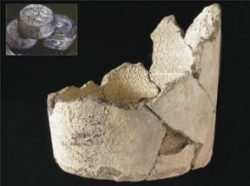Glassworks in ancient Egypt
Ancient Egyptians were producing and exporting glass more than 3,000 years ago.
By Emily Sohn
These days, glass is everywhere. It’s in your windows, your mirrors, and your drinking containers. People in ancient Egypt had glass, too, but it was special, and scientists have long debated where this valuable material came from.
Now, researchers from London and Germany have found evidence that the Egyptians were making their own glass as far back as 3,250 years ago. The discovery defies a longstanding theory that ancient Egyptians imported glass from Mesopotamia.
 |
|
Archaeologists have found a variety of items used in glassmaking, including this ceramic container, at an ancient Egyptian glass factory. Glass was colored and heated in this vessel, which is about 7 inches across. The inset shows glass ingots from a Bronze Age shipwreck near Turkey that fit Egyptian molds. |
| © Science |
The oldest known remnants of glass come from an archaeological site in Mesopotamia. The shards are 3,500 years old, and many experts assumed that this site was the source of fancy glass items found in ancient Egypt.
The new evidence, uncovered in an Egyptian village named Qantir, however, shows that an ancient glassmaking factory had operated there. Artifacts from Qantir include pottery containers holding glass chunks, along with other traces of the glassmaking process.
 |
|
This piece is all that remains of a clay funnel used to help pour glass powder into a ceramic vessel.
|
| © Science |
Chemical studies of the remains suggest how the Egyptians made their glass, the researchers say. First, the ancient glassmakers crushed quartz pebbles together with the ashes of burnt plants. Next, they heated this mixture at low temperatures in small clay jars to turn it into a glassy blob. Then, they ground the material into powder before cleaning it and using metal-containing chemicals to color it red or blue.
In the second part of the process, the glassworkers poured this refined powder through clay funnels into ceramic containers. They heated the powder to high temperatures. After it cooled, they broke the containers and removed solid disks of glass.
Egyptian glassmakers probably sold and shipped their glass to workshops throughout the Mediterranean. Artisans could then reheat the material and shape it into fancy objects.
 |
|
This map shows the Egyptian village Qantir, where a glass factory was located, and trade routes that would have carried glass from the Nile Delta to other parts of the Mediterranean.
|
| © Science |
Now that glass is so easy to come by, it might be hard to imagine how special it was back then. At the time, wealthy people exchanged sculpted glass pieces as a way to make political bonds with each other. If you hand someone a piece of glass today, they’d probably just toss it in a recycling container!—E. Sohn
Going Deeper:
Bower, Bruce. 2005. Ancient glassmakers: Egyptians crafted ingots for Mediterranean trade. Science News 167(June 18):388. Available at http://www.sciencenews.org/articles/20050618/fob3.asp .







